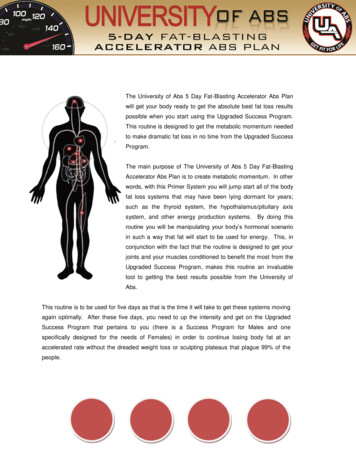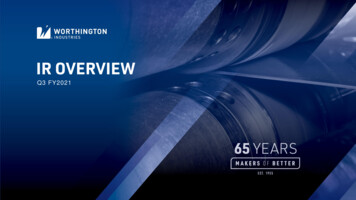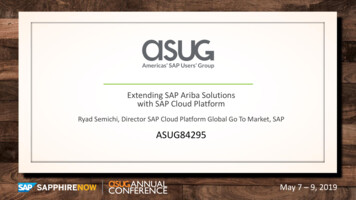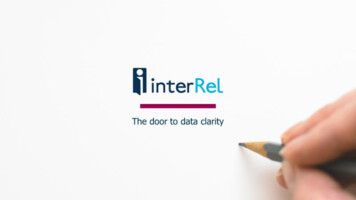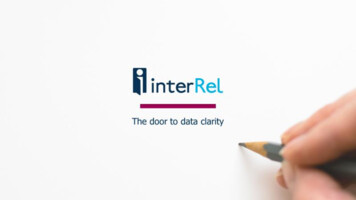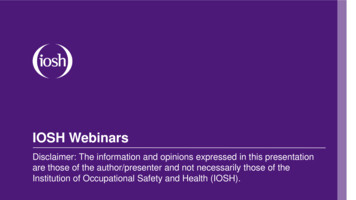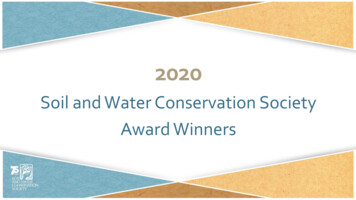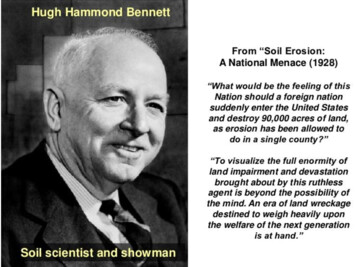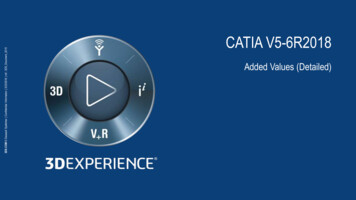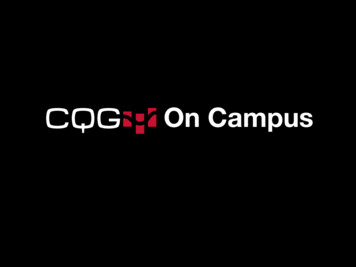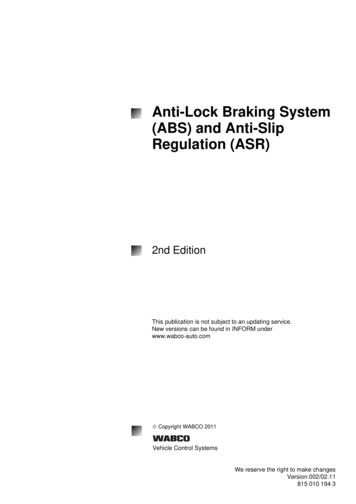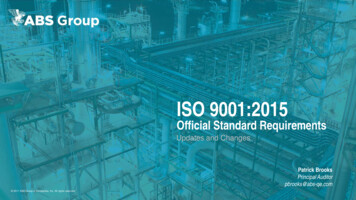
Transcription
ISO 9001:2015Official Standard RequirementsUpdates and ChangesPatrick BrooksPrincipal Auditorpbrooks@abs-qe.com 2017 ABS Group of Companies, Inc. All rights reserved.
Webinar Overview Overview of ABS GroupISO 9000:2015 Key Terms & DefinitionsISO 9001:2015 Updates & ChangesAnnex ATimelinesQuestions
Global ReachOur network of more than 1,500professionals can be reached in over30 countries with regional offices in:Americas/CorporateEuropeMiddle EastAsia/PacificHouston, TexasWarrington, UKDubai, U.A.ERepublic of SingaporeMarket SectorsService LinesOffshoreOil, Gas & ChemicalMarineGovernmentPowerTechnical Inspection and VerificationSafety, Risk and ComplianceAsset Performance OptimizationAdvanced EngineeringManagement Systems Certification
Company History and Mission ABS Group, based in Houston, Texas, is a subsidiary of ABS, one of theworld's leading marine and offshore classification societies For more than 40 years, we have built a reputation for setting standards ofexcellence in the areas of safety, risk and integrity for a broad spectrum ofclients in the marine; offshore; oil, gas and chemical; government andpower sectors The mission of ABS Group of Companies is to be a leading global providerof technical services that better enable our clients to operate safely, reliably,efficiently, and in compliance with applicable regulations and standards. Weare focused on adding value to the industries we serve and strategicallycapturing synergies with ABS.
Questions Enter your question(s) into the GoToWebinar Questions Panel at any time. Questions will be answered at the end of the presentation, as time permits. A PDF copy of this webinar’s presentation is available to download in the“Handouts” section in the GoToWebinar Panel. Today’s webinar is being recorded and will become available ars/ Please allow 2-3 business days for the webinar to be posted.
ISO 9000:2015 Key Terms & Definitions
ISO 9000:2015 Key Terms & DefinitionsContext of the Organization - An organization’s context is itsbusiness environment. It includes all of the internal and externalfactors and conditions that affect its products and services, havean influence on its QMS, and are relevant to its purpose and strategicdirection.An organization’s external context includes all of the needs andexpectations of interested parties, as well as its social, cultural,legal, technological, regulatory, and competitive environment.An organization’s internal context includes its values, culture,knowledge, and performance.
ISO 9000:2015 Key Terms & DefinitionsDocumented Information - The term documented information refers to information that mustbe controlled and maintained and its supporting medium. Documented information can bein any format and on any medium and can come from any source.Documented information includes information about the management system and relatedprocesses.It also includes all the information that organizations need to operate and all the informationthat they use to document the results that they achieve (aka records).
ISO 9000:2015 Key Terms & DefinitionsInformation - Information is “meaningful data”. While it's not entirely clear what the word“meaningful” is supposed to mean in this context, dictionaries tend to say that something ismeaningful if it is significant, relevant, material, valid, or important.Information System - In the context of this ISO 9001 standard, an information system is anetwork of communication channels used within an organization.
ISO 9000:2015 Key Terms & DefinitionsInterested Party - An interested party is anyone who can affect or be affected by a decision oractivity. An interested party is a person, group, or organization that has an interest or astake in a decision or activity.Knowledge - Knowledge is a collection of information and a justified belief that this informationis true with a high level of certainty.Knowledge is a familiarity, awareness or understanding of someone or something, such asfacts, information, descriptions, or skills, which is acquired through experience oreducation by perceiving, discovering, or learning.
ISO 9000:2015 Key Terms & DefinitionsOutsource - When an organization makes an arrangement with an outside organization toperform part of a function or process, it is referred to as outsourcing.To outsource means to ask an external organization to perform part of a function orprocess normally done in house. While an outsourced organization is beyond the scope ofyour QMS, the outsourced process or function itself falls within your scope.
ISO 9000:2015 Key Terms & DefinitionsRisk - According to ISO 9000, risk is the “effect of uncertainty on an expected result” and aneffect is a positive or negative deviation from what is expectedRisk-based thinking - Risk-based thinking refers to a coordinated set of activities andmethods that organizations use to manage and control the many risks that affect itsability to achieve objectives. Risk-based thinking replaces what the old standard used to callpreventive action.
ISO 9000:2015 Key Terms & DefinitionsTop Management - The term top management normally refers to the people at the top of anorganization. It refers to the people who provide resources and delegate authority and whocoordinate, direct, and control organizations.However, if the scope of a management system covers only part of an organization, then theterm top management refers, instead, to the people who direct and control that part of theorganization.
ISO 9001:2015 Updates & Changes
Change Has ArrivedISO 9001:2015ISO 9001:20081. Scope2. Normative References3. Terms and Definitions4. Quality Management System5. Management Responsibility6. Resource Management7. Product Realization8. Measurement, Analysis copeNormative ReferencesTerms and DefinitionsContext of the formance EvaluationsImprovement
ISO 9001:2015 Updates & ChangesKey Changes Introduction section simplified. Terms and Definitions section contents have been taken out. This section now refers to ISO9000:2015 Terms & Definitions. Leadership section now requires top management to promote awareness of the processapproach and risk based thinking. Operation section now includes requirements to prevent human error. Operation section has included "customer requirements" as a consideration whendetermining post delivery activities.
ISO 9001:2015 Updates & Changes0.2 Quality Management Principles customer focus; leadership; engagement of people; process approach; improvement; evidence-based decision making; relationship management.
ISO 9001:2015 Updates & Changes0.3 Process Approach0.3.2 Plan-Do-Check-Act Cycle0.3.3 Risk-based Thinking0.4 Relationship with other management system standards(See Annex A for details)
ISO 9001:2015 Updates & ChangesTerms and Definitions section contentshave been taken out.This section now refers to ISO 9000:2015Terms & Definitions.
ISO 9001:2015 Updates & ChangesSection 4 - Context of the OrganizationExpects you to start by understanding your organization and its context before you start developingits quality management system (QMS).It expects you to consider the external and internal issues that are relevant to your organization'spurpose and strategic direction and to think about the influence these issues could have on its QMS andthe results it intends to achieve.This means that you need to understand your organization's externalenvironment, its culture, its values, its performance, and its interestedparties before you develop its QMS.Why? Because your QMS will need to be able to manage all of these influences. Once you’veconsidered all of this, you're ready to define the scope of your QMS and to begin its development.
ISO 9001:2015 Updates & ChangesSection 5 - Leadership:Expects your organization's top management to provide leadership for its QMS byexpecting people to focus on quality and on customers, by showing that theysupport it, by: expecting them to provide compliant products and services, expecting them to manage risks and opportunities.It also expects top management to establish a quality policy and to assign QMSroles, responsibilities, and authorities.
ISO 9001:2015 Updates & ChangesSection 5 – Leadership (cont’d)Leadership section now requires top management to promote awareness of the processapproach and risk based thinking.Section 5.1.1 Generald) promoting the use of the process approach and risk-based thinking;
ISO 9001:2015 Updates & ChangesSection 6 - Planning:Expects you to plan the development of your QMS. It expects you to address the risks and opportunities that could influence yourorganization's QMS or disrupt its operation and to consider how its context and itsinterested parties could affect its QMS and the results it intends to achieve. It also expects you to set quality objectives and to develop plans to achieve them. Finally, it asks you to control changes to your QMS.
ISO 9001:2015 Updates & ChangesSection 7 - Support:Expects you to support your QMS by managing communications and by providing thenecessary resources.It expects you to provide competent people, an appropriate infrastructure and environment, suitable monitoring and measuring technologies, the knowledge that is needed to support process operations documented information.
ISO 9001:2015 Updates & ChangesSection 7 – Support (cont’d)Expects you to start by figuring out how extensive your documented information should be select and include all the documentation your organization needs in order to ensure that itsprocesses are being carried out as planned ensure that you have all the documentation needs in order to comply with the ISO 9001:2015standard. manage the creation and modification of this documentation and to control how it is used.
ISO 9001:2015 Updates & ChangesSection 8 - Operation:Expects you to develop, implement, and control the operational processes that yourorganization needs in order to provide products and services and to manage and control risksand opportunities.It requires you to clarify how product and service requirements will be managed and howcommunications with customers will be handled.
ISO 9001:2015 Updates & ChangesSection 8 – Operation (cont’d)Also expects you to establish a product and service design and development process (whennecessary), to monitor externally provided products and services, to manage production andservice provision, to supervise product and service release, and to control nonconformingoutputs in order to prevent unintended use.
ISO 9001:2015 Updates & ChangesSection 8 – Operation (cont’d)Operation section now includes requirements to prevent human error.Section 8.5.1 Control of production and service provisiong) the implementation of actions to prevent human error;Operation section has included "customer requirements" as a consideration when determiningpost delivery activities.Section 8.5.5 Post-delivery activitiesd) customer requirements;
ISO 9001:2015 Updates & ChangesSection 9 - Performance Evaluation:Expects you to monitor, measure, analyze, and evaluate the performance ofyour organization's QMS.It asks you to monitor customer satisfaction, to evaluate monitoring andmeasuring results, to audit conformance and performance, and to review thesuitability, adequacy, and effectiveness of your QMS.
ISO 9001:2015 Updates & ChangesSection 10 - Improvement:Expects you to identify opportunities to improve your organization'sprocesses, products and services, and to enhance customer satisfaction.It also asks you to control nonconformities, to take corrective actions, andto enhance the suitability, adequacy, and effectiveness of your QMS.
Annex A
Annex AA.1 Structure & Terminology1. Product is now Product and Services2. Process Approach is now a stated requirement (Clause 5.1.1 d)3. “Risk” is defined as effect of uncertainty Reference ISO 310004. Monitoring and Measurement are now separate (Clause 4.4.1 c) Monitoring: status of a system, a process or an activity Measurement: a process to determine a value
Annex AA.1 Structure & Terminology (cont’d)5) Management representative Not used(Similar responsibilities and authorities are assigned but no requirement for a singlemanagement representative)6) Documentation, quality manual, documented procedures, records, nowDocumented information7) Work environment, now Environment for the operation of processes8) Purchased product, now Externally provided products and services9) Supplier, now External provider
Annex AA.2 Products & ServicesThis edition of this International Standard uses “products and services”. Theterm “products and services” includes all output categories (hardware, services,software and processed materials).The specific inclusion of “services” is intended to highlight the differencesbetween products and services in the application of some requirements.
Annex AA.3 Understanding needs & expectations of interested partiesSub clause 4.2 specifies requirements for the organization to determine the interested parties that arerelevant to the quality management system and the requirements of those interested parties.However, 4.2 does not imply extension of quality management system requirements beyond the scope of thisInternational Standard. As stated in the scope, this International Standard is applicable where anorganization needs to demonstrate its ability to consistently provide products and services that meetcustomer and applicable statutory and regulatory requirements, and aims to enhance customer satisfaction.There is no requirement in this International Standard for the organization to consider interested partieswhere it has decided that those parties are not relevant to its quality management system.It is for the organization
ISO 9001:2015 Official Standard Requirements Updates and Changes Patrick Brooks. Principal Auditor. pbrooks@abs-qe.com 2017 ABS Group of Companies, Inc. All rights reserved.
